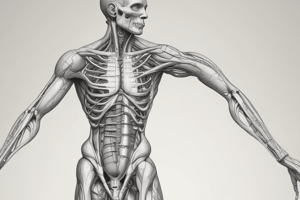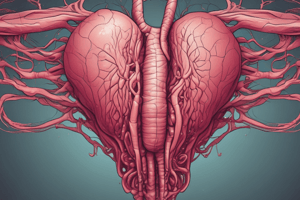Podcast
Questions and Answers
Why is the embryonic peroid considered critical despite being less sensitive to major congenital anomalies compared to the fetal stage?
Why is the embryonic peroid considered critical despite being less sensitive to major congenital anomalies compared to the fetal stage?
- Because exposure during this period primarily results in tissue injury accompanied by inflammation.
- Because infectious agents cannot cross the placental barrier during this time.
- Because maternal health factors have less influence during this stage.
- Because this is when most organogenesis occurs, making it highly susceptible to functional defects. (correct)
What is the initial indication that a particular factor might be acting as a teratogen in a population?
What is the initial indication that a particular factor might be acting as a teratogen in a population?
- Identification of the teratogen in the environment.
- Controlled experiments on animal models.
- An increase in the prevalence of specific birth defects. (correct)
- Direct observation of cellular damage in fetal tissue samples.
Which outcome is more characteristic of teratogen exposure during the fetal stage compared to the embryonic stage?
Which outcome is more characteristic of teratogen exposure during the fetal stage compared to the embryonic stage?
- Growth restriction and mental retardation.
- Major congenital anomalies affecting organ structure.
- Tissue injury and inflammation, such as encephalitis or myocarditis. (correct)
- Functional defects that impair physiological processes.
A pregnant woman is diagnosed with toxoplasmosis. Which potential fetal outcome is most closely associated with this infection?
A pregnant woman is diagnosed with toxoplasmosis. Which potential fetal outcome is most closely associated with this infection?
Which maternal factor during pregnancy has been definitively linked to both congenital anomalies and functional defects in the developing fetus?
Which maternal factor during pregnancy has been definitively linked to both congenital anomalies and functional defects in the developing fetus?
A couple is having difficulty conceiving. The woman has a history of salpingitis. Which of the following is the most likely reason for their infertility?
A couple is having difficulty conceiving. The woman has a history of salpingitis. Which of the following is the most likely reason for their infertility?
During fertilization, what specific contribution does the sperm provide that determines the sex of the offspring?
During fertilization, what specific contribution does the sperm provide that determines the sex of the offspring?
Which of the following is the correct chronological order of the stages of human development?
Which of the following is the correct chronological order of the stages of human development?
A researcher is studying the role of insulin resistance in female infertility. Which of the following conditions is most closely associated with insulin resistance and can affect fertility?
A researcher is studying the role of insulin resistance in female infertility. Which of the following conditions is most closely associated with insulin resistance and can affect fertility?
A couple is undergoing fertility testing. The male partner's semen analysis reveals impaired sperm motility. Which stage of human development is most likely to be directly affected by this condition?
A couple is undergoing fertility testing. The male partner's semen analysis reveals impaired sperm motility. Which stage of human development is most likely to be directly affected by this condition?
During a lecture on human genetics, the professor mentions that gametes contain half the number of chromosomes as somatic cells. What is the number of chromosomes present in a normal human gamete?
During a lecture on human genetics, the professor mentions that gametes contain half the number of chromosomes as somatic cells. What is the number of chromosomes present in a normal human gamete?
If both the sperm and the egg have a normal number of chromosomes, how many chromosomes will the zygote have after fertilization?
If both the sperm and the egg have a normal number of chromosomes, how many chromosomes will the zygote have after fertilization?
What is the primary difference between the roles of the sperm and the ova in fertilization?
What is the primary difference between the roles of the sperm and the ova in fertilization?
During blastocyst development, what is the correct sequence of stages leading to implantation?
During blastocyst development, what is the correct sequence of stages leading to implantation?
Around what time does HCG secretion typically start in relation to blastocyst implantation?
Around what time does HCG secretion typically start in relation to blastocyst implantation?
Embryonic development spans which of the following timeframes?
Embryonic development spans which of the following timeframes?
What is a crucial developmental milestone achieved by week 3 of embryonic development?
What is a crucial developmental milestone achieved by week 3 of embryonic development?
During which period of development does the formation of the neural tube, heart, and upper/lower extremities primarily occur?
During which period of development does the formation of the neural tube, heart, and upper/lower extremities primarily occur?
Fetal development is characterized by which timeframe?
Fetal development is characterized by which timeframe?
What are the two main criteria used to assess gestational viability during fetal development?
What are the two main criteria used to assess gestational viability during fetal development?
If a pregnant patient is at risk for early embryologic development complications, which of the following embryonic milestones, if disrupted, would be of greatest concern between weeks 2 to 8?
If a pregnant patient is at risk for early embryologic development complications, which of the following embryonic milestones, if disrupted, would be of greatest concern between weeks 2 to 8?
Which of the following best describes the relationship in Potter sequence?
Which of the following best describes the relationship in Potter sequence?
Encephalocele and Anencephaly both fall under which category of birth defects?
Encephalocele and Anencephaly both fall under which category of birth defects?
What is the primary defect in Spina bifida?
What is the primary defect in Spina bifida?
A patient presents with a newborn who has a sacral dimple and a small tuft of hair on their lower back. Which of the following conditions is MOST likely?
A patient presents with a newborn who has a sacral dimple and a small tuft of hair on their lower back. Which of the following conditions is MOST likely?
Which of the following is a known risk factor associated with neural tube defects?
Which of the following is a known risk factor associated with neural tube defects?
A pregnant woman is diagnosed with oligohydramnios. Which of the following fetal complications is MOST directly associated with this condition?
A pregnant woman is diagnosed with oligohydramnios. Which of the following fetal complications is MOST directly associated with this condition?
Which of the following neural tube defects involves a portion of the brain protruding through a gap in the skull?
Which of the following neural tube defects involves a portion of the brain protruding through a gap in the skull?
Anencephaly is characterized by which of the following?
Anencephaly is characterized by which of the following?
Which of the following is the BEST example of a disruption in morphogenesis?
Which of the following is the BEST example of a disruption in morphogenesis?
A newborn presents with multiple congenital anomalies including pulmonary hypoplasia, facial abnormalities, and limb deformities. The mother had severe oligohydramnios during pregnancy due to renal agenesis in the fetus. Which of the following BEST describes the underlying mechanism?
A newborn presents with multiple congenital anomalies including pulmonary hypoplasia, facial abnormalities, and limb deformities. The mother had severe oligohydramnios during pregnancy due to renal agenesis in the fetus. Which of the following BEST describes the underlying mechanism?
Which of the following scenarios is MOST consistent with a deformation in fetal development?
Which of the following scenarios is MOST consistent with a deformation in fetal development?
A child is born with a cleft palate, ventricular septal defect (VSD), and polydactyly. These seemingly unrelated anomalies are thought to arise from a single underlying genetic defect affecting multiple developmental pathways. Which term BEST describes this situation?
A child is born with a cleft palate, ventricular septal defect (VSD), and polydactyly. These seemingly unrelated anomalies are thought to arise from a single underlying genetic defect affecting multiple developmental pathways. Which term BEST describes this situation?
Which of the following is LEAST likely to be associated with hepatosplenomegaly in a newborn?
Which of the following is LEAST likely to be associated with hepatosplenomegaly in a newborn?
Retinoic acid is a known teratogen. What type of congenital anomaly is MOST associated with exposure to retinoic acid during pregnancy?
Retinoic acid is a known teratogen. What type of congenital anomaly is MOST associated with exposure to retinoic acid during pregnancy?
A researcher is studying the cause of congenital malformations. They are examining a case of cleft palate and suspect it is multifactorial in origin. Which of the following BEST describes what 'multifactorial' implies in this context?
A researcher is studying the cause of congenital malformations. They are examining a case of cleft palate and suspect it is multifactorial in origin. Which of the following BEST describes what 'multifactorial' implies in this context?
Which of the following is NOT considered a common symptom that warrants investigation for potential underlying congenital issues in a newborn?
Which of the following is NOT considered a common symptom that warrants investigation for potential underlying congenital issues in a newborn?
Flashcards
Teratogen
Teratogen
A substance that can cause developmental abnormalities following fetal exposure.
Teratogen Discovery
Teratogen Discovery
Often identified after a noticeable increase in the occurrence of a specific birth defect.
Types of Teratogens
Types of Teratogens
Infectious agents, medications/drugs, physical agents, maternal health factors, and environmental chemicals.
TORCH Infections
TORCH Infections
Signup and view all the flashcards
TORCH Effects (Embryonic)
TORCH Effects (Embryonic)
Signup and view all the flashcards
Fertilization
Fertilization
Signup and view all the flashcards
Gametes
Gametes
Signup and view all the flashcards
Sex Determination
Sex Determination
Signup and view all the flashcards
Blastocyst Development
Blastocyst Development
Signup and view all the flashcards
Embryologic Development
Embryologic Development
Signup and view all the flashcards
Fetal Development
Fetal Development
Signup and view all the flashcards
Polycystic Ovarian Syndrome (PCOS)
Polycystic Ovarian Syndrome (PCOS)
Signup and view all the flashcards
Fallopian Tube Stricture
Fallopian Tube Stricture
Signup and view all the flashcards
Hepatosplenomegaly
Hepatosplenomegaly
Signup and view all the flashcards
Poor feeding
Poor feeding
Signup and view all the flashcards
Growth retardation
Growth retardation
Signup and view all the flashcards
Jaundice
Jaundice
Signup and view all the flashcards
Thrombocytopenia
Thrombocytopenia
Signup and view all the flashcards
Malformations
Malformations
Signup and view all the flashcards
Disruptions
Disruptions
Signup and view all the flashcards
Deformations
Deformations
Signup and view all the flashcards
Fetal Alcohol Syndrome
Fetal Alcohol Syndrome
Signup and view all the flashcards
Potter Sequence
Potter Sequence
Signup and view all the flashcards
Neural Tube Defects
Neural Tube Defects
Signup and view all the flashcards
Encephalocele
Encephalocele
Signup and view all the flashcards
Anencephaly
Anencephaly
Signup and view all the flashcards
Spina Bifida
Spina Bifida
Signup and view all the flashcards
Folate deficiency
Folate deficiency
Signup and view all the flashcards
Sacral Dimple or Tuft of Hair
Sacral Dimple or Tuft of Hair
Signup and view all the flashcards
Implantation Timing
Implantation Timing
Signup and view all the flashcards
HCG Secretion
HCG Secretion
Signup and view all the flashcards
Embryonic Period
Embryonic Period
Signup and view all the flashcards
Primary Germ Layers
Primary Germ Layers
Signup and view all the flashcards
Critical Development
Critical Development
Signup and view all the flashcards
Gestational Viability
Gestational Viability
Signup and view all the flashcards
Study Notes
- Human development encompasses fertilization through fetal development.
- Key objectives involve identifying stages, recognizing abnormalities, teratogens, and congenital anomalies in human embryonic development
Stages of Human Development
- Fertilization marks the first stage.
- Blastocyst development and implantation follow fertilization.
- Embryologic development is the third stage.
- Fetal development is the final stage.
Fertilization (Day 0)
- Gametes, sperm, and ova, contain 23 chromosomes each.
- The father's sperm determines the sex of the offspring.
Potential Problems with Fertilization and Implantation
- Fertilization failure can occur.
- Defective sperm capacitation and acrosomal reaction
- Fallopian tubal blockage
- A ripened egg might not be released through ovulation.
- Polycystic Ovarian Syndrome and insulin resistance can cause errors.
- Fallopian tube stricture secondary to salpingitis.
- Sperm dysmotility
- Altered Oviductal Environment from growth factors, hormones, proteases, antioxidants, glycosidases, proteoglycans, cytokines, and glycoproteins.
- Implantation failure can occur
- Altered uterine secretions could happen.
- Defective endometrium receptivity.
- Altered adhesion between selectins, integrins, cadherins, trophinin, and heparin-binding epidermal growth factor (HB-EGF)
- Various conditions or issues that can occur include uterine causes, systemic causes, rejection, problems with the maternal body or the embryo itself.
Blastocyst Development & Implantation.
- Fast cell division happens, Zygote converts to Morula then a Blastocyst
- Implantation occurs between days 6 and 10.
- HCG secretion starts around the time of implantation.
- The blastocyst attaches to the uterine wall on day six.
Early embryologic Development.
- Occurs between weeks 2-8
- There are primary germ layers by week 3:
- Ectoderm
- Mesoderm
- Endoderm
Weeks 2 to 8 Embryo Development
- Organogenesis begins
Ectoderm derivatives include:
- Neural crest
- Nerves, Schwann cells
- Neural tube
- Brain, spinal cord
- Surface ectoderm
- Epidermis
Mesoderm Derivatives
- Muscles
- Bones
- Connective tissue
- Heart
- Urogenital System
Endoderm Derivatives
- Gut tube
- Liver
- Pancreas
- Lungs
- Thymus
- Parathyroid
Potential Problems of the Embryo
- Age
- 4 weeks with a neural tube defect
- Heart can have issues.
- Limbs can develop defect.
Fetal Development includes
- Weeks 9-38
- The period is critical for functional defects, but less sensitive for major congenital anomalies compared to later stages.
Effects of Teratogens on Fetal Development
- Major congenital anomalies are most likely to occur during the embryonic period.
- Functional defects and minor anomalies are more common during the fetal stage.
- Neural tube defects, truncus arteriosus, atrial septal defect, mental retardation indicate neural tube defects
Teratogens
- Any agent that causes an abnormality following fetal exposure
- Commonly discovered after an increased prevalence of a particular birth defect.
- Examples include infectious agents, medications, recreational drugs, physical agents (like radiation or hyperthermia), maternal health factors (like diabetes), and environmental chemicals.
Infectious TORCH agents include
- Toxoplasma gondii
- Others: HIV, Hepatitis, Syphilis, Varicella-Zoster, Parvovirus
- Rubella
- Cytomegalovirus
- Herpes simplex virus
- During the embryologic state, TORCH infections can cause growth restriction, mental retardation, cataracts, and congenital cardiac anomalies.
- In the fetal stage, tissue injury is the main result, leading to encephalitis, chorioretinitis, hepatosplenomegaly, pneumonia, and myocarditis.
Common Symptoms of TORCH Infections include
- Hepatosplenomegaly, fever, poor feeding, growth retardation, jaundice, thrombocytopenia, hearing impairment, developmental delay, autism, and potentially death.
Substances - Legal and Illegal
- ACE inhibitors: Can cause renal failure, oligohydramnios, hypocalvaria.
- Alkylating agents: Can cause multiple anomalies, such as ear/facial abnormalities or absence of digits.
- Aminoglycosides: Can cause Ototoxicity.
- Antiepileptic drugs: Can cause neural tube defects, cardiac defects, cleft palate, and skeletal abnormalities.
- Diethylstilbestrol: Can cause vaginal clear cell adenocarcinoma and congenital Müllerian anomalies.
- Fluoroquinolones: Can cause Cartilage damage
- Folate antagonists: Can cause neural tube defects
- Isotretinoin: Can cause Craniofacial defects.
- Lithium: Can Ebstein anomaly
- Methimazole: Can cause Aplasia cutis congenita .
- Tetracyclines: Can cause discolored teeth and inhibited bone growth.
- Thalidomide: Can cause Limb defects.
- Warfarin: Can cause bone and cartilage deformities, optic nerve atrophy, and cerebral hemorrhage.
- Substance use-Alchohol: Fetal alcohol syndrome.
- Cocaine: Can cause Preterm birth, low birth weight, and fetal growth restriction .
- Tobacco Smoking: Can cause Preterm birth, low birth weight, FGR, sudden infant death syndrome , and ADHD.
Errors in Morphogenesis
- Agenesis: Absent organ due to absent primordial tissue.
- Aplasia: Absent organ despite presence of primordial tissue.
- Hypoplasia: Incomplete organ development, primordial tissue present.
- Disruption: Secondary breakdown of tissue with normal developmental potential
- Deformation: Extrinsic mechanical distortion (e.g., congenital torticollis) during the fetal period.
- Malformation: Intrinsic developmental defect (e.g., cleft lip/palate) during the embryonic period.
- Sequence: Abnormalities result from a single primary embryologic event (e.g., oligohydramnios Potter sequence).
- Field defect: Disturbance of tissues that develop in a contiguous physical space.
- Malformations result from intrinsically abnormal development, with severity ranging from incidental to lethal, e.g., cleft lip/palate
- Disruptions result from secondary destruction of previously normal organs or body regions due to environmental agents, e.g., amniotic bands.
- Deformations represent extrinsic disturbance of development due to localized or generalized compression of the growing fetus, e.g., congenital arthrogryposis
- Sequence - One or more secondary morphologic anomalies known or presumed to cascade from single malformation
- Syndrome - Recognizable pattern of congenital anomalies that are know or thought to be casually related
Potter Sequence
- Begins with oligohydramnios, leading to fetal growth restriction and organ hypoplasia.
Neural Tube Defects
- Occurs when the caudal neuro is not closed.
Neural Tube Defects (cranial end)
- Encephalocele: A portion of the brain protrudes through a gap in the skull
- Anencephaly: Cranial part of the neural tube fails to close during fetal development.
Neural Tube Defects (caudal end)
- SpIna bifida is the most common NTD failure of the neural tube.
- Associated with folate deficiency.
- It can be prevented with adjust Rx and supplement! -Types of Spina bifida
- Sacral dimple or tuft of hair is Occulta which is less common:
- Meningocele most serious type covering of the spinal cord
- In the spinal cord enclosed in the cyst the called more more type myelomeningocele
Studying That Suits You
Use AI to generate personalized quizzes and flashcards to suit your learning preferences.





